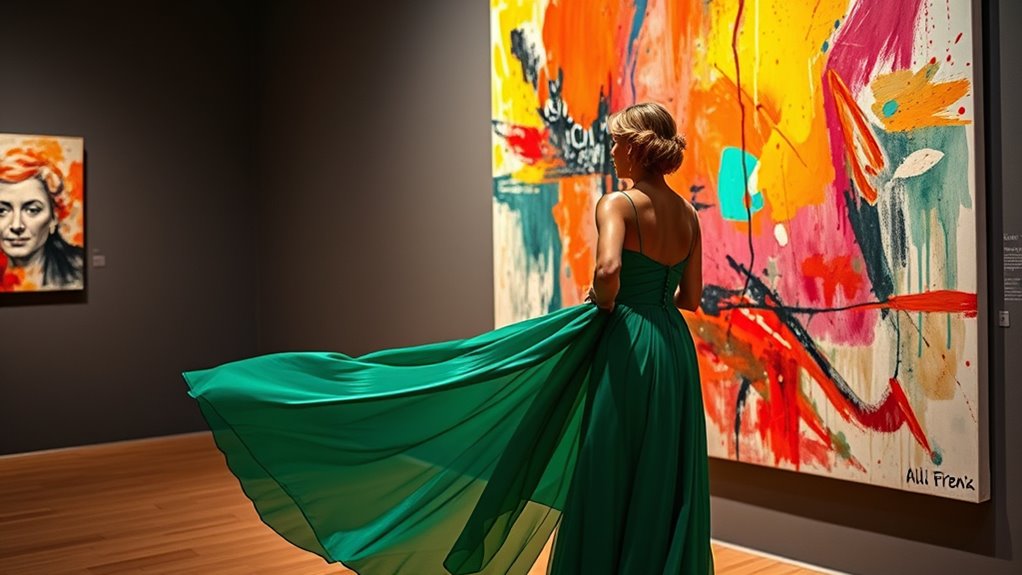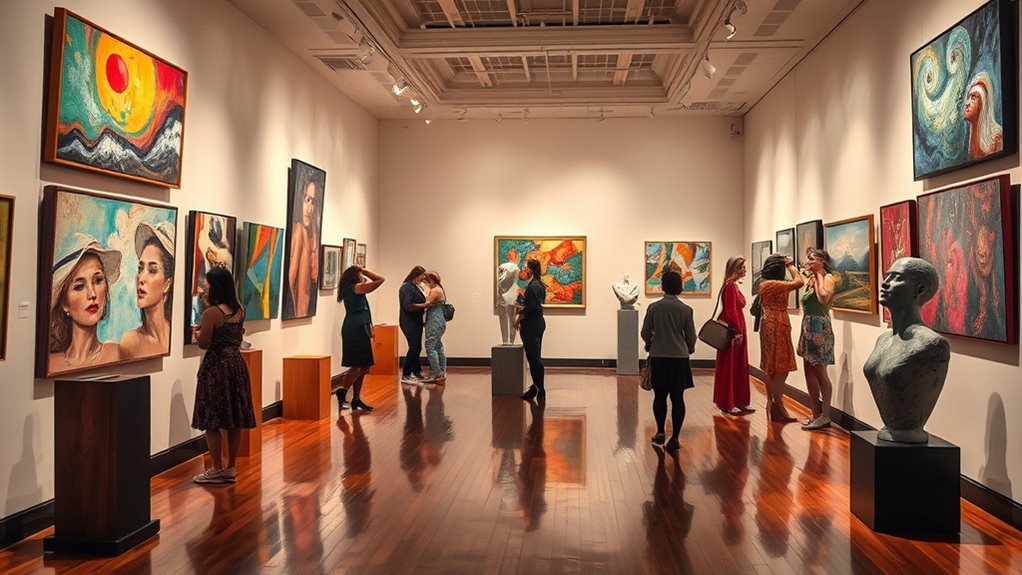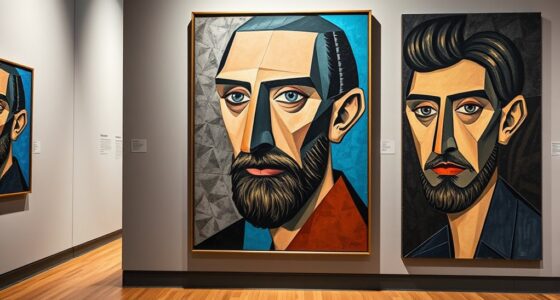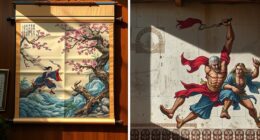Women in art have faced many challenges, but pioneering female artists like Frida Kahlo and Artemisia Gentileschi broke barriers and gained recognition. Despite societal limits, they used their creativity to express identity, pain, and social themes. Growing awareness and improved education opportunities now support women artists more than ever. Their stories continue to inspire change and reshape art history. Keep exploring to discover more about how these trailblazing women made their mark.
Key Takeaways
- Historically, women’s artistic contributions were marginalized and undervalued due to societal norms and limited access to art education.
- Pioneering female artists like Frida Kahlo and Artemisia Gentileschi challenged gender expectations and made significant impacts through their innovative work.
- Increased art education opportunities and scholarships have empowered women to develop skills and gain recognition in the art world.
- Highlighting women’s achievements in art helps correct historical biases and promotes more inclusive art narratives.
- Ongoing efforts aim to address disparities and promote gender equality, fostering greater diversity and innovation in art.

Have you ever wondered how women have shaped the course of art history? Their contributions often went unnoticed or undervalued, but today, more than ever, we’re beginning to recognize the essential role women have played in shaping artistic movements and redefining gender representation. This shift isn’t just about celebrating individual artists; it’s about challenging historical biases that kept women on the margins of art education and recognition. Historically, art education was largely inaccessible to women, and societal norms limited their opportunities to develop and showcase their talents. Many talented women were confined to domestic roles, and even when they pursued art, they faced barriers that prevented their work from gaining prominence. Today, however, there’s a growing awareness of the importance of gender representation in the arts, and efforts are underway to address these disparities.
As the landscape changes, more women are gaining access to art education, breaking down the walls that once restricted their creative pursuits. Art schools are increasingly diversifying their curricula and scholarships to support women artists, recognizing that a more inclusive environment results in richer artistic expressions. This progress has led to a surge of pioneering female artists whose works challenge traditional narratives and inspire new generations. Women like Frida Kahlo, whose raw, emotive paintings explore identity and pain, or Artemisia Gentileschi, whose Baroque masterpieces defy gender expectations, exemplify how art can be a powerful tool for self-expression and social commentary. Their stories remind us that women have always been at the forefront of innovation, even if history didn’t always record it. Additionally, art education access has played a crucial role in empowering women artists to develop their skills and gain recognition. Increasing public awareness about these artists helps to shift perceptions and elevate their contributions within the broader art world. Furthermore, understanding the historical barriers faced by women in art underscores the ongoing need for gender equality in the arts, which continues to be a vital step toward a more inclusive artistic landscape. Recognizing these achievements also helps to correct historical misrepresentations and promote a more accurate understanding of art history.
Frequently Asked Questions
How Did Societal Norms Impact Women’S Artistic Opportunities Historically?
You might notice that societal norms historically limited women’s artistic opportunities by reinforcing strict gender roles. These norms often restricted your artistic freedom, making it harder to access training, exhibitions, or recognition. Women were expected to focus on domestic roles, which kept them away from the art world. As a result, many talented women faced barriers that prevented them from fully expressing or developing their artistic talents.
Which Female Artists Broke Through Major Art Institutions?
You see that many female artists broke through major institutions by challenging gender norms and gaining recognition. They benefited from gender equity initiatives that promoted female artist recognition, helping them access galleries and exhibitions historically dominated by men. These pioneers paved the way for future generations, demonstrating that perseverance and advocacy can overcome societal barriers and achieve greater visibility for women in the art world.
How Has Female Representation in Art Changed Over the Centuries?
Like a sunrise breaking through clouds, female representation in art has steadily brightened over centuries. You see, gender stereotypes once limited women’s artistic recognition, keeping them in shadows. Today, more women challenge those stereotypes, gaining acknowledgment for their talent and contributions. While progress is visible, you still recognize the ongoing need to dismantle barriers. So, the evolution continues, shaping a more inclusive and balanced artistic landscape for everyone.
What Barriers Do Contemporary Women Artists Face Today?
Today, you face barriers like gender bias that still influence how your work is perceived and valued. Funding disparities also limit your opportunities, making it harder to access resources and showcase your art. Despite progress, these obstacles can hinder your growth and visibility in the art world. Recognizing these challenges helps push for equality, ensuring your talent receives the recognition it deserves without unfair barriers.
How Can Institutions Better Support Women in the Arts?
You can help institutions better support women in the arts by advocating for mentorship programs and funding initiatives dedicated to female artists. Encourage them to create spaces where women can network, share resources, and receive guidance. Push for policies that ensure equal opportunities, visibility, and recognition. By doing so, you empower women artists to thrive, break barriers, and reshape the art world into a more inclusive, equitable environment.
Conclusion
As you step back and admire the vibrant tapestry woven by these pioneering women, you realize their legacy is a blazing trail of color and courage. Their stories shimmer like stars in a night sky, guiding future generations through uncharted creative domains. By celebrating their brilliance, you breathe life into a world where women’s voices echo loudly, transforming the canvas of art into a masterpiece of equality and inspiration. Keep their light shining bright—you’re part of this ongoing masterpiece.









